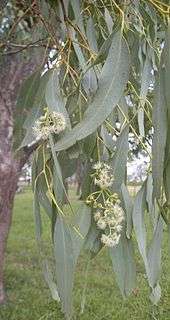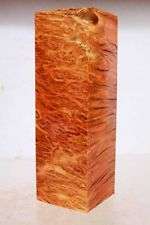Eucalyptus coolabah
| Coolibah | |
|---|---|
 | |
| Scientific classification | |
| Kingdom: | Plantae |
| Clade: | Angiosperms |
| Clade: | Eudicots |
| Clade: | Rosids |
| Order: | Myrtales |
| Family: | Myrtaceae |
| Genus: | Eucalyptus |
| Species: | E. coolabah |
| Binomial name | |
| Eucalyptus coolabah Blakely & Jacobs | |



Eucalyptus coolabah, commonly known as coolibah,[1] is a eucalypt of riparian zones and is found throughout Australia from arid inland to coastal regions. The plant is commonly called coolibah or coolabah, the name being a loanword from the Indigenous Australian Yuwaaliyaay word, gulabaa.[2]
Description
E. coolabah is a wide-spreading tree (often wider than tall) and reaches up to 20 metres (66 ft) in height. The bark is box-like, persistent, dark grey, thick and furrowed on the trunk and lower branches, but smooth pale grey up the top. The grey-green, dull and concolorous adult leaves are disjunct with a narrow-lanceolate to lanceolate shape. The leaf blade is 8 to 17 centimetres (3.1 to 6.7 in) in length and 1 to 2 cm (0.39 to 0.79 in) wide.[3]
The compound conflorescence has seven flowered umbellasters on flattened to angular peduncles that are 1 to 9 millimetres (0.039 to 0.354 in) long with terete pedicels 1 to 4 mm (0.039 to 0.157 in) long.[3] It will later form buds that are ovoid in shape with a length of 2 to 4.5 mm (0.079 to 0.177 in) and a diameter of 2 to 3 mm (0.079 to 0.118 in). Fruits form later with a globose or hemispherical shape with a narrow flat disc and exserted valves. The fruit are 2 to 4 mm (0.079 to 0.157 in) in length with a similar diamter and contain red-brown seeds.[3]
Propagation is dependent on periods of immersion under water to sterilise seedbeds; as a result, the species is restricted to locales that experience at least periodic flooding. Nonetheless, the tree can be found over extensive areas of floodplain far from permanent water, as well as near seasonally flooded springs or close to permanent bodies of water.
Similar species
E. coolabah is very similar to E. microtheca. The main external difference is that the latter has rough bark to the small branches, while in E. coolabah the branches have smooth white, pale grey, or pink bark. E. coolabah was once known as E. microtheca (which now has a number of subspecies), before splitting.
Classification
The tree was first formally described by the botanists William Blakely and Maxwell Jacobs in 1934 in the work A Key to the Eucalypts. There are several synonyms for the species including Eucalyptus gymnoteles, Eucalyptus coolabah Blakely & Jacobs subsp. coolabah, Eucalyptus coolabah subsp. excerata L.A.S.Johnson & K.D.Hill and Eucalyptus coolabah subsp. arida (Blakely) L.A.S.Johnson & K.D.Hill.[4]
Distribution
The tree is found in western New South Wales,[3] north western South Australia,[5] the Kimberley region of Western Australia[1], western Queensland[6] and southern to central parts of the Northern Territory.[7]
The tree occurs on occasionally flooded heavy-soiled plains and banks of intermittent streams and creeks. The watercourses will usually not flow often enough to support the river red gum, Eucalyptus camaldulensis var. obtus.[7]
Uses
The wood typically has a density of 900 to 1,100 kilograms per cubic metre (56 to 69 lb/cu ft). The heartwood is a reddish brown colour and much darker than the sapwood. Indigenous Australians used the wood to make spear, fire-making apparatus, message sticks, coolamons (wooden dish) and throwing sticks. They would also obtain water from the rootwood.[8]
See also
- List of Eucalyptus species
- "Waltzing Matilda"—the coolabah tree is mentioned in this famous folk song
- The Dig Tree—the coolabah tree is a landmark which marks the place where Camp LXV was set up by Burke and Wills’ party attracting over 35,000 tourists each year.[9]
References
- 1 2 "Eucalyptus coolabah". FloraBase. Western Australian Government Department of Parks and Wildlife.
- ↑ The Macquarie Concise Dictionary, The Macquarie Library, Sydney, 1998, ISBN 0-949757-95-0
- 1 2 3 4 "Eucalyptus coolabah Blakely & Jacobs". PlantNET. Royal Botanic Garden Sydney. Retrieved 30 July 2017.
- ↑ "Eucalyptus coolabah Blakely & Jacobs". The Atlas of Living Australia. Global Biodiversity Information Facility. Retrieved 30 July 2017.
- ↑ "Eucalyptus coolabah (Myrtaceae) Coolabah". Seeds of South Australia. Government of South Australia. Retrieved 30 July 2017.
- ↑ "Coolabah – Eucalyptus coolabah". WetlandInfo. Department of Environment and Heritage Protection, Queensland. Retrieved 30 July 2017.
- 1 2 "Eucalyptus coolabah Blakely & Jacobs". NT Flora. Northern Territory Government. Retrieved 30 July 2017.
- ↑ "Eucalyptus coolabah Blakely & Jacobs". Arid Australian Hardwoods. lucidcentral. Retrieved 30 July 2017.
- ↑ "Level of Significance". National Trust. Retrieved 30 July 2017.
- Holliday, I. A field guide to Australian trees (3rd edition), Reed New Holland, 2002
- Cronin, L. Key Guide to Australian Trees, Envirobook, 2000
External links
![]() Media related to Eucalyptus coolabah at Wikimedia Commons
Media related to Eucalyptus coolabah at Wikimedia Commons
| Look up coolibah or coolabah in Wiktionary, the free dictionary. |